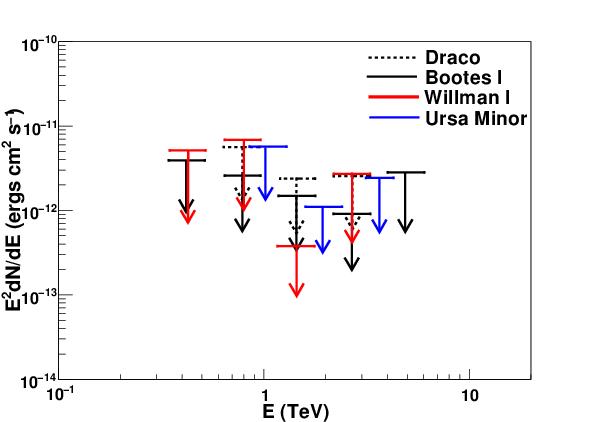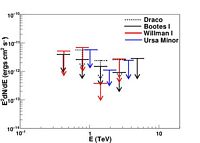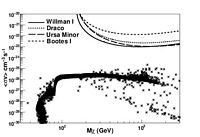
Reference: V. A. Acciari et al. (The VERITAS Collaboration), Astrophysical Journal 720: 1174-1180, 2010
Full text version here
ArXiv version: ArXiV:1006.5955
Contact person: Bob Wagner
Indirect dark matter searches with ground-based gamma-ray observatories provide an alternative for identifying the particle nature of dark matter that is complementary to that of direct search or accelerator production experiments. We present the results of observations of the dwarf spheroidal galaxies Draco, Ursa Minor, Boötes 1, and Willman 1 conducted by the Very Energetic Radiation Imaging Telescope Array System (VERITAS). These galaxies are nearby dark matter dominated objects located at a typical distance of several tens of kiloparsecs for which there are good measurements of the dark matter density profile from stellar velocity measurements. Since the conventional astrophysical background of very high energy gamma rays from these objects appears to be negligible, they are good targets to search for the secondary gamma-ray photons produced by interacting or decaying dark matter particles. No significant gamma-ray flux above 200 GeV was detected from these four dwarf galaxies for a typical exposure of ∼ 20 hours. The 95% confidence upper limits on the integral gamma-ray flux are in the range 0.4−2.2×10−12 photons cm−2s−1. We interpret this limiting flux in the context of pair annihilation of weakly interacting massive particles (WIMPs) and derive constraints on the thermally averaged product of the total self-annihilation cross section and the relative velocity of the WIMPs (<σv> ≤ 10−23 cm3 s−1 for m χ < 300 GeV/c2). This limit is obtained under conservative assumptions regarding the dark matter distribution in dwarf galaxies and is approximately three orders of magnitude above the generic theoretical prediction for WIMPs in the minimal supersymmetric standard model framework. However significant uncertainty exists in the dark matter distribution as well as the neutralino cross sections which under favorable assumptions could further
Figures from paper (click to get full size image):



